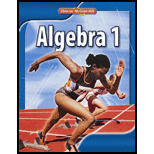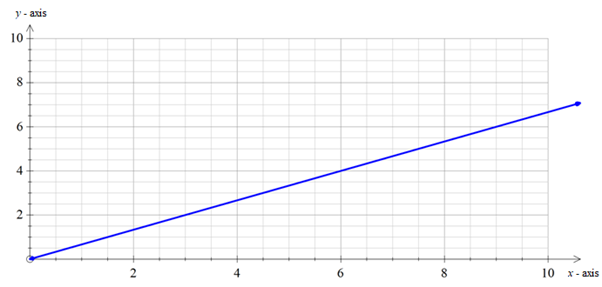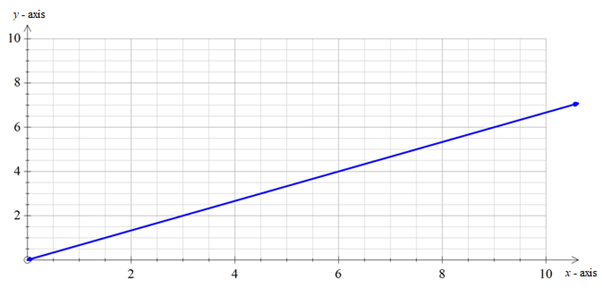
a
To make a table showing the relation between body and water weight for people weighing 100, 105, 110,120,125 and 130 pounds.
a
Explanation of Solution
Given:
The given relation is
Where w = weight of water in pounds.
b = body weight in pounds.
Calculation:
When the body weight ( b) =100 pounds, weight of water ( w ) is =
Similarly,
| Values of ‘ b’ | Values of ‘ w’ |
| 100 | |
| 105 | |
| 110 | |
| 120 | |
| 125 | |
| 130 |
Conclusion:
The above table shows the relation between body and water weight for people.
b
To identify the dependent and independent variables from the given relation.
b
Answer to Problem 37PPS
Weight of body is independent variable.
Weight of water is dependent variable.
Explanation of Solution
Given:
The given relation is
Independent variables are those variables which keeps on changing and they are unaffected by the change of any other parameter. For example: - Time.
Hence, Weight of the body ( b) is the deciding parameter which does not depend on other variable. So it is the independent variable.
Weight of the water ( w) depends on weight of the body ( b) as per the given relation.
So, the Weight of the water is the dependent variable.
Conclusion:
Therefore, weight of body is independent variable and weight of water is dependent variable.
c
To write: the domain and range of the relation
c
Answer to Problem 37PPS
Domain
Range
Explanation of Solution
Given:
The relation is
Domain is all the values of x - axis that is defined in the given relation.
Range is all the values of y - axis that are possible for corresponding values of x - axis.
Hence, for the relation
Calculation for graph:
Consider
| Values of ‘ b’ | Values of ‘ w’ |
| 100 | |
| 105 | |
| 110 | |
| 120 | |
| 125 | |
| 130 |
By taking different values of b , the graph can be plotted.
Graph:

Interpretation:
From the above graph, it is clear that,
As the weight of the body increases, the weight of the water also increases.
d
To reverse the independent and dependent variable of the given relation, graph it and interpret the meaning of the graph.
d
Explanation of Solution
Given:
The relation is
Here, Weight of the body ( b ) is the independent variable.
Weight of water ( w) is the dependent variable
The given relation after reversing the independent and dependent variable is
This means, for every 3 pounds of water, there will be 2 pounds of body weight for an adult.
Calculation for graph:
Consider
| Values of ‘ w’ | Values of ‘ b’ |
| 100 | |
| 105 | |
| 110 | |
| 120 | |
| 125 | |
| 130 |
Graph:

In the above graph, x - axis denotes the weight of the water ( w) in pounds.
y - axis denotes the weight of the body ( b ) in pounds.
Interpretation:
From the above graph, it is clear that,
As the weight of the water increases, the weight of the body also increases.
Chapter 1 Solutions
Algebra 1
Additional Math Textbook Solutions
Basic Business Statistics, Student Value Edition
A First Course in Probability (10th Edition)
Elementary Statistics (13th Edition)
Thinking Mathematically (6th Edition)
Introductory Statistics
Calculus: Early Transcendentals (2nd Edition)
- Solve the following system of equations: 50x+20y=1800 10x+3y=300arrow_forward> > > we are hiring Salesforce Admin Location: Remote Key Responsibilities: Administer Salesforce Sales & Revenue Cloud (CPQ & Billing) Configure workflows, validation rules & dashboards Automate processes using Flows & Process Builder Collaborate with Sales, Finance & Marketing teams Manage user roles & security Apply: Hr@forcecraver.comarrow_forwardAnswer this questionarrow_forward
- 1. vector projection. Assume, ER1001 and you know the following: ||||=4, 7=-0.5.7. For each of the following, explicitly compute the value. འབ (a) (b) (c) (d) answer. Explicitly compute ||y7||. Explain your answer. Explicitly compute the cosine similarity of and y. Explain your Explicitly compute (x, y). Explain your answer. Find the projection of onto y and the projection of onto .arrow_forward2. Answer the following questions using vectors u and v. --0-0-0 = find the the cosine similarity and the angle between u and v. འརྒྱ (a) (b) find the scalar projection of u onto v. (c) find the projection of u onto v. (d) (e) (f) find the scalar projection of onto u. find the projection of u onto u. find the projection of u onto and the projection of onto . (Hint: find the inner product and verify the orthogonality)arrow_forwardPlease type out answerarrow_forward
- The function f(x) = log x is transformed to produce g(x) = log (x) – 3. Identify the type of transformation and describe the change. Please type out answerarrow_forwardEach graph below is the graph of a system of three linear equations in three unknowns of the form Ax = b. Determine whether each system has a solution and, if it does, the number of free variables. A. O free variables ✓ B. no solution C. no solution D. no solution E. 1 free variable F. 1 free variablearrow_forwardSolve the following systems of equations and show all work.y = x2 + 3y = x + 5 Please type out answerarrow_forward
 Algebra and Trigonometry (6th Edition)AlgebraISBN:9780134463216Author:Robert F. BlitzerPublisher:PEARSON
Algebra and Trigonometry (6th Edition)AlgebraISBN:9780134463216Author:Robert F. BlitzerPublisher:PEARSON Contemporary Abstract AlgebraAlgebraISBN:9781305657960Author:Joseph GallianPublisher:Cengage Learning
Contemporary Abstract AlgebraAlgebraISBN:9781305657960Author:Joseph GallianPublisher:Cengage Learning Linear Algebra: A Modern IntroductionAlgebraISBN:9781285463247Author:David PoolePublisher:Cengage Learning
Linear Algebra: A Modern IntroductionAlgebraISBN:9781285463247Author:David PoolePublisher:Cengage Learning Algebra And Trigonometry (11th Edition)AlgebraISBN:9780135163078Author:Michael SullivanPublisher:PEARSON
Algebra And Trigonometry (11th Edition)AlgebraISBN:9780135163078Author:Michael SullivanPublisher:PEARSON Introduction to Linear Algebra, Fifth EditionAlgebraISBN:9780980232776Author:Gilbert StrangPublisher:Wellesley-Cambridge Press
Introduction to Linear Algebra, Fifth EditionAlgebraISBN:9780980232776Author:Gilbert StrangPublisher:Wellesley-Cambridge Press College Algebra (Collegiate Math)AlgebraISBN:9780077836344Author:Julie Miller, Donna GerkenPublisher:McGraw-Hill Education
College Algebra (Collegiate Math)AlgebraISBN:9780077836344Author:Julie Miller, Donna GerkenPublisher:McGraw-Hill Education





